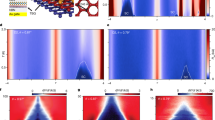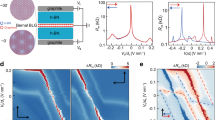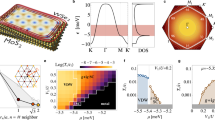Abstract
Achieving electrostatic control of quantum phases is at the frontier of condensed matter research. Recent investigations have revealed superconductivity tunable by electrostatic doping in twisted graphene heterostructures and in two-dimensional semimetals such as WTe2 (refs. 1,2,3,4,5). Some of these systems have a polar crystal structure that gives rise to ferroelectricity, in which the interlayer polarization exhibits bistability driven by external electric fields6,7,8. Here we show that bilayer Td-MoTe2 simultaneously exhibits ferroelectric switching and superconductivity. Notably, a field-driven, first-order superconductor-to-normal transition is observed at its ferroelectric transition. Bilayer Td-MoTe2 also has a maximum in its superconducting transition temperature (Tc) as a function of carrier density and temperature, allowing independent control of the superconducting state as a function of both doping and polarization. We find that the maximum Tc is concomitant with compensated electron and hole carrier densities and vanishes when one of the Fermi pockets disappears with doping. We argue that this unusual polarization-sensitive two-dimensional superconductor is driven by an interband pairing interaction associated with nearly nested electron and hole Fermi pockets.
This is a preview of subscription content, access via your institution
Access options
Access Nature and 54 other Nature Portfolio journals
Get Nature+, our best-value online-access subscription
$29.99 / 30 days
cancel any time
Subscribe to this journal
Receive 51 print issues and online access
$199.00 per year
only $3.90 per issue
Buy this article
- Purchase on Springer Link
- Instant access to full article PDF
Prices may be subject to local taxes which are calculated during checkout




Similar content being viewed by others
Data availability
Datasets used to construct plots and support other findings in this article are available from the corresponding authors upon request.
References
Cao, Y. et al. Unconventional superconductivity in magic-angle graphene superlattices. Nature 556, 43–50 (2018).
Liu, X. et al. Tunable spin-polarized correlated states in twisted double bilayer graphene. Nature 583, 221–225 (2020).
Park, J. M., Cao, Y., Watanabe, K., Taniguchi, T. & Jarillo-Herrero, P. Tunable strongly coupled superconductivity in magic-angle twisted trilayer graphene. Nature 590, 249–255 (2021).
Fatemi, V. et al. Electrically tunable low-density superconductivity in a monolayer topological insulator. Science 362, 926–929 (2018).
Sajadi, E. et al. Gate-induced superconductivity in a monolayer topological insulator. Science 362, 922–925 (2018).
Zheng, Z. et al. Unconventional ferroelectricity in moiré heterostructures. Nature 588, 71–76 (2020).
De la Barrera, S. C. et al. Direct measurement of ferroelectric polarization in a tunable semimetal. Nat. Commun. 12, 5298 (2021).
Fei, Z. et al. Ferroelectric switching of a two-dimensional metal. Nature 560, 336–339 (2018).
Rabe, K. M., Dawber, M., Lichtensteiger, C., Ahn, C. H. & Triscone, J.-M. in Physics of Ferroelectrics 1–30 (Springer, 2007).
Yasuda, K., Wang, X., Watanabe, K., Taniguchi, T. & Jarillo-Herrero, P. Stacking-engineered ferroelectricity in bilayer boron nitride. Science 372, 1458–1462 (2021).
Wang, X. et al. Interfacial ferroelectricity in rhombohedral-stacked bilayer transition metal dichalcogenides. Nat. Nanotechnol. 17, 367–371 (2022).
Liu, Y., Liu, S., Li, B., Yoo, W. J. & Hone, J. Identifying the transition order in an artificial ferroelectric van der Waals heterostructure. Nano Lett. 22, 1265–1269 (2022).
Sando, D., Barthélémy, A. & Bibes, M. BiFeO3 epitaxial thin films and devices: past, present and future. J. Phys. Condens. Matter 26, 473201 (2014).
Ye, J. et al. Liquid-gated interface superconductivity on an atomically flat film. Nat. Mater. 9, 125–128 (2010).
Hamill, A. et al. Two-fold symmetric superconductivity in few-layer NbSe2. Nat. Phys. 17, 949–954 (2021).
Rhodes, D. A. et al. Enhanced superconductivity in monolayer Td-MoTe2. Nano Lett. 21, 2505–2511 (2021).
Yuan, S. et al. Room-temperature ferroelectricity in MoTe2 down to the atomic monolayer limit. Nat. Commun. 10, 1775 (2019).
Deng, K. et al. Experimental observation of topological Fermi arcs in type-IIWeyl semimetal MoTe2. Nat. Phys. 12, 1105–1110 (2016).
Jiang, J. et al. Signature of type-II Weyl semimetal phase in MoTe2. Nat. Commun. 8, 13973 (2017).
Qi, Y. et al. Superconductivity in Weyl semimetal candidate MoTe2. Nat. Commun. 7, 11038 (2016).
Wang, W. et al. Evidence for an edge supercurrent in the Weyl superconductor MoTe2. Science 368, 534–537 (2020).
Xi, X. et al. Ising pairing in superconducting NbSe2 atomic layers. Nat. Phys. 12, 139–143 (2016).
Yang, Q., Wu, M. & Li, J. Origin of two-dimensional vertical ferroelectricity in WTe2 bilayer and multilayer. J. Phys. Chem. Lett. 9, 7160–7164 (2018).
Liu, X. et al. Vertical ferroelectric switching by in-plane sliding of two-dimensional bilayer WTe2. Nanoscale 11, 18575–18581 (2019).
Sondheimer, E. & Wilson, A. H. The theory of the magneto-resistance effects in metals. Proc. R. Soc. Lond. A 190, 435–455 (1947).
Chen, F. et al. Extremely large magnetoresistance in the type-II Weyl semimetal MoTe2. Phys. Rev. B 94, 235154 (2016).
Ali, M. N. et al. Large, non-saturating magnetoresistance in WTe2. Nature 514, 205–208 (2014).
Zandt, T., Dwelk, H., Janowitz, C. & Manzke, R. Quadratic temperature dependence up to 50 K of the resistivity of metallic MoTe2. J. Alloys Compd 442, 216–218 (2007).
Hussey, N., Buhot, J. & Licciardello, S. A tale of two metals: contrasting criticalities in the pnictides and hole-doped cuprates. Rep. Progr. Phys. 81, 052501 (2018).
Greene, R. L., Mandal, P. R., Poniatowski, N. R. & Sarkar, T. The strange metal state of the electron-doped cuprates. Ann. Rev. Condens. Matter Phys. 11, 213–229 (2020).
Cao, Y. et al. Strange metal in magic-angle graphene with near Planckian dissipation. Phys. Rev. Lett. 124, 076801 (2020).
Ghiotto, A. et al. Quantum criticality in twisted transition metal dichalcogenides. Nature 597, 345–349 (2021).
Fernandes, R. M. et al. Iron pnictides and chalcogenides: a new paradigm for superconductivity. Nature 601, 35–44 (2022).
Zhai, B., Li, B., Wen, Y., Wu, F. & He, J. Prediction of ferroelectric superconductors with reversible superconducting diode effect. Phys. Rev. B 106, L140505 (2022).
Li, X. et al. Terahertz field-induced ferroelectricity in quantum paraelectric SrTiO3. Science 364, 1079–1082 (2019).
Ji, S., Granas, O. & Weissenrieder, J. Manipulation of stacking order in Td-WTe2 by ultrafast optical excitation. ACS Nano 15, 8826–8835 (2021).
Gan, Y. et al. Bandgap opening in MoTe2 thin flakes induced by surface oxidation. Front. Phys. 15, 33602 (2020).
Wang, L. et al. One-dimensional electrical contact to a two-dimensional material. Science 342, 614–617 (2013).
Kresse, G. & Furthmüller, J. Efficiency of ab-initio total energy calculations for metals and semiconductors using a plane-wave basis set. Comput. Mater. Sci. 6, 15–50 (1996).
Kresse, G. & Furthmüller, J. Efficient iterative schemes for ab initio total-energy calculations using a plane-wave basis set. Phys. Rev. B 54, 11169 (1996).
Blöchl, P. E. Projector augmented-wave method. Phys. Rev. B 50, 17953 (1994).
Kresse, G. & Joubert, D. From ultrasoft pseudopotentials to the projector augmented-wave method. Phys. Rev. B 59, 1758 (1999).
Perdew, J. P. et al. Restoring the density-gradient expansion for exchange in solids and surfaces. Phys. Rev. Lett. 100, 136406 (2008).
Brown, B. E. The crystal structures of WTe2 and high-temperature MoTe2. Acta Crystallogr. 20, 268–274 (1966).
Monkhorst, H. J. & Pack, J. D. Special points for Brillouin-zone integrations. Phys. Rev. B 13, 5188 (1976).
Mostofi, A. A. et al. wannier90: A tool for obtaining maximally-localised Wannier functions. Comput. Phys. Commun. 178, 685–699 (2008).
Marzari, N., Mostofi, A. A., Yates, J. R., Souza, I. & Vanderbilt, D. Maximally localized Wannier functions: theory and applications. Rev. Mod. Phys. 84, 1419 (2012).
Graser, S., Maier, T., Hirschfeld, P. & Scalapino, D. Near-degeneracy of several pairing channels in multiorbital models for the Fe pnictides. N. J. Phys. 11, 025016 (2009).
Christensen, M. H., Kang, J., Andersen, B. M. & Fernandes, R. M. Spin-driven nematic instability of the multiorbital Hubbard model: Application to iron-based superconductors. Phys. Rev. B 93, 085136 (2016).
Python Tight Binding (PythTB) (2021); http://physics.rutgers.edu/pythtb/
Acknowledgements
We thank A. Millis for discussions. The experimental portion of this research was primarily supported by the NSF MRSEC program through Columbia University in the Center for Precision-Assembled Quantum Materials under award no. DMR-2011738 (fabrication, measurements and data analysis). A.S., T.B. and R.M.F. (theoretical modelling) were supported by the National Science Foundation through the University of Minnesota MRSEC (grant no. DMR-2011401). D.A.R. and Z.L. (growth, measurements and data analysis) were supported by the University of Wisconsin-Madison, Office of the Vice Chancellor for Research and Graduate Education with funding from the Wisconsin Alumni Research Foundation. D.A.R. was partially supported by the NSF MRSEC program through the University of Wisconsin-Madison under award no. DMR-1720415. A.N.P. acknowledges salary support from the NSF via grant no. DMR-2004691, from AFOSR via grant no. FA9550-21-1-0378 by the ARO-MURI program with award no. W911NF-21-1-0327. K.W. and T.T. acknowledge support from the Element Strategy Initiative conducted by the MEXT, Japan (grant no. JPMXP0112101001) and JSPS KAKENHI (grant nos. 19H05790, 20H00354 and 21H05233).
Author information
Authors and Affiliations
Contributions
The experiment was designed by D.A.R., A.J. and A.N.P. Devices were fabricated by A.J., D.A.R. and Z.L. C.R.D., A.J. and D.A.R. performed the measurements and analysed the data. A.S. developed theoretical models and performed calculations supervised by T.B. and R.F.M. T.T. and K.W. supplied hBN single crystals. D.A.R. and J.C.H. synthesized MoTe2 single crystals. D.A.R., A.J. and A.N.P. wrote the manuscript with the input of all other authors.
Corresponding authors
Ethics declarations
Competing interests
The authors declare no competing interests.
Peer review
Peer review information
Nature thanks Yoichi Yanase, Kenji Yasuda and the other, anonymous, reviewer(s) for their contribution to the peer review of this work. Peer reviewer reports are available.
Additional information
Publisher’s note Springer Nature remains neutral with regard to jurisdictional claims in published maps and institutional affiliations.
Extended data figures and tables
Extended Data Fig. 1 Superconducting dome observed in two other devices at D = 0 V/nm.
Limitations due to the dielectric strength of the hBN in these devices precluded us from reaching higher doping and, consequently, the formation of a complete superconducting dome.
Extended Data Fig. 2 Doping dependent T-linear behaviour of bilayer Td - MoTe2.
a, Colour plot of resistance vs temperature and doping. Doping dependent superconducting critical temperature (from Fig. 3a) is superimposed on the colour plot with the associated temperature scale on the right axis. b, Diagram indicating regions of T2 and T-linear behaviour. c,Rxx versus temperature for various dopings, as indicated at the top of each curve in values of 1013 cm−2. Blue (red) dashed lines indicate quadratic (linear) fits to the data.
Extended Data Fig. 3 T-linear behaviour observed in D3.
a, Colour plot of resistance vs temperature and doping. Doping dependent superconducting critical temperature (from Extended Data Fig. 2) is superimposed on the colour plot. b,Rxx versus temperature for various dopings. Blue (red) dashed lines indicate quadratic (linear) fits to the data.
Supplementary information
Supplementary Information
This file contains eight figures and a table that are used as supporting information for the main text figures and explanations.
Rights and permissions
Springer Nature or its licensor (e.g. a society or other partner) holds exclusive rights to this article under a publishing agreement with the author(s) or other rightsholder(s); author self-archiving of the accepted manuscript version of this article is solely governed by the terms of such publishing agreement and applicable law.
About this article
Cite this article
Jindal, A., Saha, A., Li, Z. et al. Coupled ferroelectricity and superconductivity in bilayer Td-MoTe2. Nature 613, 48–52 (2023). https://doi.org/10.1038/s41586-022-05521-3
Received:
Accepted:
Published:
Issue Date:
DOI: https://doi.org/10.1038/s41586-022-05521-3
This article is cited by
-
Robust multiferroic in interfacial modulation synthesized wafer-scale one-unit-cell of chromium sulfide
Nature Communications (2024)
-
Metal telluride nanosheets by scalable solid lithiation and exfoliation
Nature (2024)
-
High-throughput computational stacking reveals emergent properties in natural van der Waals bilayers
Nature Communications (2024)
-
Recent advances in memristors based on two-dimensional ferroelectric materials
Frontiers of Physics (2024)
-
0D van der Waals interfacial ferroelectricity
Nature Communications (2023)
Comments
By submitting a comment you agree to abide by our Terms and Community Guidelines. If you find something abusive or that does not comply with our terms or guidelines please flag it as inappropriate.



